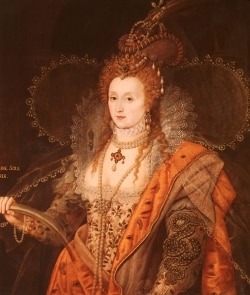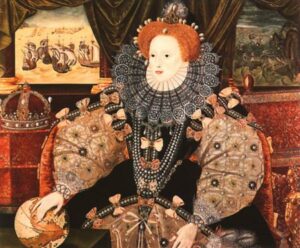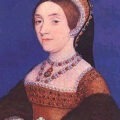 Shows like “The Tudors”, films like “Elizabeth” “Elizabeth: The Golden Age”, “The Other Boleyn Girl” and Tudor exhibitions and festivals have all renewed our interest in the Tudor period and the way that men and women dressed and accessorised.
Shows like “The Tudors”, films like “Elizabeth” “Elizabeth: The Golden Age”, “The Other Boleyn Girl” and Tudor exhibitions and festivals have all renewed our interest in the Tudor period and the way that men and women dressed and accessorised.
Jewellery was a big part of Tudor fashion, for those who were rich and important, because it showed both their wealth and status.
But jewels were not just used to accessorise and show off, as Alison Sim writes in “Pleasures and Pastimes in Tudor England”, jewellery “was also used to convey political messages, to display religious beliefs and to remind people of their friends and relatives who had died.” However, we do need to remember that jewellery wearing in Tudor times was not as widespread as it is today and that it was just essentially worn by the upper classes, those who could afford such finery.
So, what types of jewellery did the Tudor upper classes wear?
Mourning jewellery – Mourning rings were a way of remembering loved ones who had died. Unlike later mourning rings which would contain a lock of hair or miniature, Tudor mourning rings tended to just have words engraved, words like “Remember Me”. “Memento mori” (Latin for “remember you shall die”) jewellery pieces were reminders that death was imminent, rather than being reminders of loved ones, and death was truly imminent when you think that the average life expectancy was just 35! These pieces were usually rings or pendants set with clasped hands, skeletons and skulls.
Chains – Gold chains were popular with those at court but men tended to wear them to reflect their status. You may have seen the state chains that Sir Thomas More, Thomas Cromwell and Henry VIII wore in “The Tudors” and the ones worn in their portraits.
Special chains of office included those for the Order of the Garter, the Order of the Golden Fleece and the Collar of Esses. Gold chains were also popular wedding gifts for women. Fake gold chains, known as “St Martin’s Chain”, were quite common. The name came from the fact that jewelers making fake jewellery had ancient rights of sanctuary in the parish of St Martin Le Grand and could work without fear of contravening the Goldsmiths’ Company regulations.
Buttons and aglets – Clothing was fastened with buttons or laces and aglets were pointed pieces of metal that were attached to the ends of laces to prevent them fraying and to make it nice and easy for the laces to be threaded through eyelets. Both buttons and aglets could be simple or decorative. Alison Sims writes of how Elizabeth I had buttons in the form of lover’s knots, roses, acorns and hearts, and that the wealthy would use buttons and aglets made from precious metals or set with gems like rubies.
Girdles – Women used girdles which hung round the waist and then down the skirt of their gowns to accessorise. These girdles could be made of silk or jewels and have decorations hanging from them. In the famous “Dynasty” portrait, Jane Seymour is shown wearing a girdle of pearls with a gold medallion set with a large jewel. Other decorations included a small prayer book, a mirror or jewelled pomander, which would contain either perfume or sweet smelling herbs.
Initialled pendants – We have all seen Anne Boleyn’s B necklace in her portraits, in “The Tudors” and even in “Ugly Betty” and pendants like these showing your family’s initials were quite common in Tudor times. It is thought that some of Anne Boleyn’s jewellery was handed down to her daughter, Elizabeth, and that she wore her mother’s famous necklace.
Other pendants – Pendants could be hung from pearls, chains or ribbons round the neck, or attached to hats, gowns and girdles. Crosses, jewels and lockets (known as “tablets”) were all popular pendants.
Brooches – Brooches were used to accessorise or to fasten clothing like cloaks. They were also used to decorate hats and buckles.
Bracelets – Tudor bracelets tended to be made out of silver or gold and decorated with precious stones, but strands of pearls could also be wrapped around the wrist.
Jewelled accessories – Jewels were used to decorate many different items, such as fan handles, tooth picks and pomanders.
Earrings – Earrings or “ear pickes” became more popular when hood fashions changed and ears could be seen. Earrings ranged from single stud jewels to hanging pendants and, like today, men could also wear a single earring.
Necklaces – Necklaces could be strands of pearls, like Anne Boleyn’s B necklace, or gold or silver necklaces encrusted with precious stones, like in the portrait of Princess Elizabeth (see the top of the article). Necklaces in Tudor times were known as “carcanets” and tended to be choker style necklaces. Other necklaces included rope style necklaces which could be draped and fixed in different ways using a pin or brooch, and chains, which when worn by women used to be a fine filigree style.
Rosaries – Rosaries or rosary beads were strings of beads used by Catholics to count prayers. They could be simple beads, coloured glass or even precious stones. Elizabeth I banned rosary beads in 1571 but Catholic people got round this by wearing a rosary ring, which had ten prayer studs projecting from it.
Rings – Rings worn by rich Tudors included mourning rings, signet rings, solitairs, cluster style rings and rings set with jewels, like those in our shop set with onyx, sapphires, pearls and rubies.
Jewelled furs – Alison Sims describes this very strange accessory as “a single pelt of a small animal such as a sable which would be virtually made into a piece of jewellery” and writes of how Henry VIII had two sables – one had a clock set into its head and was decorated with rubies and diamonds. It also had paws decorated with gold and claws made of sapphires. The second sable had a ruby for a tongue and was set with diamonds, pearls, rubies and turquoise!
Precious stones Used in Tudor Jewellery
Many different precious stones were used in Tudor jewellery and some were used because of their special meanings and properties. For example, agates were thought to start storms, to help with the interpretation of dreams and to make the person wearing the stone more “agreeable”, and sapphires were thought to cure melancholy and to be good for your eyes.
Other precious and semi-precious stones popular in Tudor times include: diamonds, pearls, emeralds, rubies, opals, topaz, onyx, turquoise, crystal, carnelian, amber, bloodstone and coral.
Fake and imitation gems were quite popular and were often made from glass with coloured foil placed behind it. Alison Sim suggests that even some of Elizabeth I’s pearls were probably glass ones.
Jewellery Worn by the Poor
Poorer Tudor people could still have jewellery but it would be made from materials like bone, horn, metal, wood, glass and mother of pearl.


In the top portrait, Princess Elizabeth, appears to be wearing her mother, Anne Boleyn’s famous pearl necklace with the hanging initial “B” with pearls attached. I read about this else where and believe the painting is the family portrait of HenryVII, Jane Seymour, young Edward VI, Mary I, Elizabeth I, along with Henry’s parents, Henry VIII and Elizabeth of York. I find it interesting she was allowed to wear this necklace in the painting. Of course B could have been said to stand for Bess, a nickname her father might have called her.
Great article, Claire!
This article on Tudor jewelry, specifically the part about the initial pendant shared by Anne Boleyn and her daughter Elizabeth, ties into my NEW feature-length article on BeingBess: “Death Could Not Separate Them: How Elizabeth I Connected to Her Deceased Mother.”
In it, I answer the commonly asked question, “How did Elizabeth I feel about her mother, Anne Boleyn?”
“Using a surprising amount of contemporary evidence and a little bit of conjecture based on fact, I believe I have arrived at a formed opinion on the matter, and I am excited to share it with my readers. Hopefully you will discover things here that you did not know before, and upon finishing the article, share with others how Queen Elizabeth I really felt about her mother, Queen Anne Boleyn.”
This article not only includes information about Anne Boleyn’s necklace, (I have included a close-up image of the “A” pendant the young Elizabeth is wearing in the the “Family of King Henry VIII” portrait) but many more surprising ties between Elizabeth and Anne.
The Link:
http://www.beingbess.blogspot.com/2012/08/death-could-not-separate-them-how.html
SEMPER EADEM,
Ashlie Jensen of “BeingBess”
http://beingbess.blogspot.com
“BeingBess” is dedicated to celebrating the life of Elizabeth Tudor (1533-1603) and the legacy of her reign as Queen of England (1558-1603).
What date did you publish this article? Day, month, year. It doesnt have to be exact just ball park. i need it for citing for a school project. Thanks so much! The article is really helpful!
Hi Charlotte,
I posted it on 17th July 2009. Good luck with your project.
Wonderfully written and full of information. Thank you for your time and details!
Claaaire!
Thank you sooo much!!!
I’m in love with your site!
I’m doing a research to my college, and and only found information about her jewellery here! (and i’m from Brasil )
You have so many posts and amazing informations here!
Congrats for your incredible job!
I have no words to thank you enough!
this is amazing!!!
My daughter has a Tudor day coming up and im sure she will be a beautiful queen
We do renaissance costumes and I have just finished making
a costume patterned after a portrait of Robert Dudley of the
Queen Elizabeth era circa 1570. I am trying to find a necklace
similar to the one he is wearing. I could send you his photo
but don’t see how to do it with this email. You can Google Robert
Dudley and see him wearing this necklace with his leather jerkin
and red/maroon shirt and pants. Any help or even a lead would be
greatly appreciated. Thank you very much.
mitch gaspard @ 218-558-1234
Hi Claire,
Thank you for this post. I was wondering if you can tell me the source of “Elizabeth I banned rosary beads in 1571”? Specifically, I am interested in ascertaining if 1571 was indeed the year she banned them and any historical record of such a ban.
Thank you for your help!
Laura S.
Hi Claire,
I read about all of the fabulous Tudor gems and can’t help but wonder what happened to most of them. I know some survive, but that seems relatively rare. Were they recut or repurposed when the next ruler came into power? In one of Alison Weir’s books she mentions Henry the 8th had “heavy gold collars with diamonds the size of walnuts suspended from them.” Any idea where they are?
Thanks so much for your great website and all of the interesting information!
Cheers!